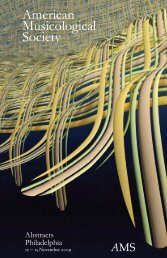Abstracts - American Musicological Society
Abstracts - American Musicological Society
Abstracts - American Musicological Society
Create successful ePaper yourself
Turn your PDF publications into a flip-book with our unique Google optimized e-Paper software.
L4<br />
ThursdaY afternoon<br />
,rhe waves of rhe vo1ga,,(K6t'a Kabanov6), -"things and<br />
shadows " (Makropolus ) , and convicts (E4m-jtE-!'9'gE-c---9E<br />
the Dead), these ll-s't'ant and usually wordless "no::::'<br />
share a common (and even commonplace) musical protrre:<br />
the simple :I-4-5 interval pattern. This is not<br />
fortuitous, since the careful dramatic placement , of<br />
these choruses makes explicit their symbolic function<br />
in representing the central theme of Jan56ek's operas:<br />
the restoratlon of natural cycles.<br />
GREAT-RAG-SKETCHES<br />
Tom Gordon, Bishop' s University, Qu6bec<br />
Unl ike its straightforlrard companlons,<br />
Stravinskyt s Piano-Rag-Music is neither parody nor<br />
genre portrait. Rather, as the hyphens in the tiCle<br />
inply, it is a collage of quasi-improvisatory<br />
fragments , an anomoly in Stravinsky' s oeuvre for its<br />
rej ection of meter and its eccentricities of structure.<br />
The evolution of Piano-Rag-Music is documented in a<br />
disproportionately large quantity of sketches. Close<br />
examination of these substantiates the very particular<br />
nature of the work and certain hypotheses on<br />
Stravinsky' s compositional process.<br />
The earliest sketches for Piano-Rag-Music date<br />
from the winter of 1918. By the time the twelve-page<br />
holograph was inked in June 1919, the composer had<br />
fi1led 55 pages in two sketchbooks. Comparison of the<br />
work's published form with these sketches leads to the<br />
following conclusions :<br />
1) Stravinsky's pre-occupations in Piano-Rag-Music<br />
rrere essentially rhythmic. While pitch configurations<br />
vary 1itt1e from the earliest sketches, as many as five<br />
variants can be found for each rhythmic form.<br />
2) The work's opening motto evolved through a process<br />
of distillacion across the sketches. Rather than<br />
generating the composition, the work's opening<br />
measures, virtually the last to appear in the sketches,<br />
were generaced by it.<br />
3) The abrupt disjunctions which articulate the work<br />
veil a fundamental unity. Continuity was "composed<br />
out" of the materials in the course of sketching, as<br />
fragment order was continuously realigned'<br />
4) A collage form is suggested at every stage of<br />
composition. The sketches indicate an<br />
interchangeability of rhythmic motives, I'hile the<br />
holograph implies that the materials may be performed<br />
in other than the Published order.<br />
The "Great-Rag-Mus1c" sketches (one nf +L<br />
composer' s worklng titles ) reweal Stravinskv<br />
"-"^', ^--i"'<br />
the possibllities of composed improvisait;'"'.:iliC<br />
deweloplng the central techniques that<br />
_:t',.f.<br />
style from P6trouchka<br />
---*vLcr<br />
onward<br />
"t "r^.nll, rze his










